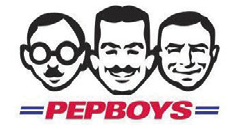Pep Boys Launches Companywide TMS
August 2012 Integrated Solutions For Retailers
By Bob Johns, associate editor
The company aims to improve supply chain visibility, accuracy, and efficiency with an upgraded transportation management system.
 Pep Boys, with roughly 750 stores and 7,000 service bays, is one of the largest auto parts and service providers in the U. S. Started in 1921 by four Navy buddies in Philadelphia, Pep Boys has grown to over $2 billion in revenue and employs more than 16,000 people. With a company this size, transportation management can be a nightmare. That is why Pep Boys began an integral relationship with Transplace to implement a transportation management system (TMS) as early as 2006.
Pep Boys, with roughly 750 stores and 7,000 service bays, is one of the largest auto parts and service providers in the U. S. Started in 1921 by four Navy buddies in Philadelphia, Pep Boys has grown to over $2 billion in revenue and employs more than 16,000 people. With a company this size, transportation management can be a nightmare. That is why Pep Boys began an integral relationship with Transplace to implement a transportation management system (TMS) as early as 2006.
That relationship has grown into a long-term partnership that includes the addition of business intelligence, data management, and reporting. Joshua Dolan, director of global logistics and trade compliance for Pep Boys (who recently moved to a similar position with Dick’s Sporting Goods), works directly with Transplace to optimize this relationship. “The idea was to build relationships with suppliers to become a preferred shipper within retail,” Dolan said. Like most of retail, Pep Boys suffered a major downturn in 2008 and into 2009 due to the economic freefall, so the company began leveraging volume and capacity with the TMS to save both time and money. “We relied on Transplace to be the experts in managing the solution and continuously increase efficiencies,” Dolan notes. “At Pep Boys’ direction, the system is constantly being enhanced as Transplace actively seeks feedback from the users within our company.”
Real-Time Access Yields Results
The TMS solution is a SaaS-based solution that resides entirely within the cloud. This allows Pep Boys, its suppliers, and Transplace to view load status in real time. “We look at data on multiple dashboards to look at aggregate data daily, monthly, quarterly, and yearly to spot trends across the system. Additionally, the inventory management group and transportation and logistics groups are looking at data in real time to see what has been picked up, what hasn’t, and where there may be an issue with a DC,” Dolan pointed out. As the needs of the company have changed over time, Pep Boys has been able to alter load sizes, frequencies, delivery times, and other logistical functions of the company quickly and efficiently based upon the reporting and visibility it now has within the supply chain. The entire system can be viewed from a higher “10,000 foot” view, down to individual load distribution and delivery to the DC. “The dashboards are very intuitive and customer friendly. We needed to make sure that as we increased the management of the logistical data, we would be able to quickly and easily access this information to make adjustments at different levels,” Dolan notes. “The system allows us to make fact-based decisions on carrier performance. We can manage our business, and through reporting, understand our business to make these better decisions.”Pep Boys can now spot trends within carrier organizations that were not visible before. A steady decline in on-time shipments, or shipments that have gradually had more damages, may not have been spotted until the issue was so large that it caused major problems. The company can now spot these trends early, contact the carriers to find out what the issue is, and take corrective action before it costs Pep Boys time and money. The carriers know that they are monitored, which allows them to judge their own performance as well.
Pep Boys, through its TMS, maintains that the company, its carriers, and its suppliers must coordinate a strategic alliance of goals. Dolan points out that, “This includes everyone from Transplace to our individual suppliers and DC workers. We must maintain a level of commitment that involves communication to adjust the TMS to benefit everyone involved. The more we interact with the TMS, and involve input from the carriers and suppliers, the more efficient the system becomes, and the more money Pep Boys saves.”
